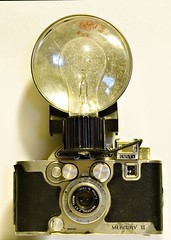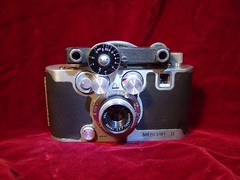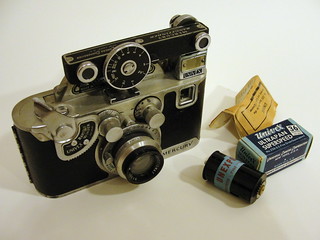Difference between revisions of "Mercury"
(Added photograph) |
(+new picture from the pool, showing rangefinder. Noted need for special roll film, and what Rick Oleson says about how that's packed.) |
||
| Line 1: | Line 1: | ||
| − | The [[Univex]] '''Mercury''' is a half-frame viewfinder camera with a rotary shutter. | + | The [[Univex]] '''Mercury''' is a half-frame viewfinder camera with a rotary shutter. Early cameras use special 35mm roll film; later ones accept standard 35mm cassettes. The camera was introduced in 1938. |
{{Flickr_image | {{Flickr_image | ||
|image_source= http://www.flickr.com/photos/kratz/3512716373/in/pool-camerawiki/ | |image_source= http://www.flickr.com/photos/kratz/3512716373/in/pool-camerawiki/ | ||
| Line 31: | Line 31: | ||
The Universal Camera Corporation found great success in the early/mid 1930s by selling very inexpensive cameras (such as the [[Univex Model A]]) and film. By the late 30s, however, the camera-buying public had shown an increasing interest in high-end imports such as the [[Leica]] and [[Contax]] lines, and the simple plastic still cameras offered by Universal up to that point were no competition. Universal solved this problem in October of 1938, with the release of the '''Univex Mercury''' (Model CC). | The Universal Camera Corporation found great success in the early/mid 1930s by selling very inexpensive cameras (such as the [[Univex Model A]]) and film. By the late 30s, however, the camera-buying public had shown an increasing interest in high-end imports such as the [[Leica]] and [[Contax]] lines, and the simple plastic still cameras offered by Universal up to that point were no competition. Universal solved this problem in October of 1938, with the release of the '''Univex Mercury''' (Model CC). | ||
| − | Cast from an aluminum alloy and covered with leather, the Mercury was not only unlike anything Universal had offered before, it was actually a revolutionary achievement | + | Cast from an aluminum alloy and covered with leather, the Mercury was not only unlike anything Universal had offered before, it was actually a revolutionary achievement. Important features worth noting include the unique rotary shutter (responsible for the circular protrusion on top of the camera), capable of extremely accurate speeds up to 1/1000th of a second. Additionally, the Mercury was the first camera to have internal flash synchronization, known today as the [[hot shoe]]. |
| − | German-made cameras from Leitz and Zeiss were selling for hundreds of dollars, making the American-made Mercury | + | German-made cameras from Leitz and Zeiss were selling for hundreds of dollars, making the American-made Mercury at a mere $25 a very appealing alternative. Nonetheless, producing America's fastest candid camera did not satisfy Universal, as the [[Contax II]] claimed a shutter speed of 1/1250. Thus, in June of 1939, Universal introduced the Mercury Model CC-1500, named after its top shutter speed. |
The Mercury Model CC-1500 is hard to find today, as only (an estimated) 3,000 were manufactured, compared to approximately 45,000 of the standard Mercury Model CC. | The Mercury Model CC-1500 is hard to find today, as only (an estimated) 3,000 were manufactured, compared to approximately 45,000 of the standard Mercury Model CC. | ||
| − | === | + | === Mercury I (model CC)=== |
| + | {|class="floatright plainlinks" style="margin:0px 0px 20p 20px;" | ||
| + | | | ||
{{Flickr_image | {{Flickr_image | ||
|image_source= http://www.flickr.com/photos/pmarinangeli/4309027199/in/pool-camerawiki/ | |image_source= http://www.flickr.com/photos/pmarinangeli/4309027199/in/pool-camerawiki/ | ||
| − | |image= http://farm3.static.flickr.com/2702/ | + | |image= http://farm3.static.flickr.com/2702/4309027199_0770ec3bbd_n.jpg |
| − | |image_align= | + | |image_align= |
| − | |image_text= Mercury I, model CC | + | |image_text= Mercury I, model CC, with accessory lightmeter<br/>fitted in the shoe |
|image_by= Paola Marinangeli | |image_by= Paola Marinangeli | ||
|image_rights= wp | |image_rights= wp | ||
}} | }} | ||
| − | *Type: viewfinder camera | + | | |
| − | + | {{Flickr_image | |
| + | |image_source= https://www.flickr.com/photos/rick_oleson/6118979542/ | ||
| + | |image= http://farm7.staticflickr.com/6069/6118979542_478326912b_n.jpg | ||
| + | |image_align= | ||
| + | |image_text= Mercury I with accessory rangefinder and rapid winder,<br/>and with a roll of Univex rollfilm | ||
| + | |image_by= Rick Oleson | ||
| + | |image_rights= wp | ||
| + | }} | ||
| + | |- | ||
| + | |} | ||
| + | The first Mercury uses Univex 200-series roll film. This is 35mm film on a simple spool, sold without a paper leader, backing paper, or even a wrapping inside the box.<ref>Rick Oleson's caption to his picture of the camera with a roll of the film (above), notes that the roll he bought has no paper wrap; 'it just uses the outer layers of the film to protect the working film, like Regular 8mm movie film'.</ref> | ||
| + | |||
| + | *Type: viewfinder camera (accessory uncoupled rangefinder available) | ||
*Year of launch: 1938 (Model CC-1500 launched in 1939) | *Year of launch: 1938 (Model CC-1500 launched in 1939) | ||
| − | *Film: Univex #200-series film, for 65 half | + | *Film: Univex #200-series film, for 65 half-frame (18×24mm) exposures |
*Construction: Aluminum alloy | *Construction: Aluminum alloy | ||
*Viewfinder: Galilean type optical finder | *Viewfinder: Galilean type optical finder | ||
| Line 55: | Line 69: | ||
*Dimensions: 138×88×60mm | *Dimensions: 138×88×60mm | ||
*Weight: 530g | *Weight: 530g | ||
| − | |||
| − | |||
| − | |||
| − | The '''Mercury II''' | + | ===Mercury II (model CX)=== |
| + | The '''Mercury II''' is a post-War reincarnation of the Mercury I, produced from 1945. | ||
Universal Camera Corp. suspended their normal camera-making operations during World War II in order to manufacture binoculars for the armed forces. By the time the war ended and Universal resumed camera production, they had decided to revamp the popular Mercury in order to allow it to accept standard 35mm film rolls (as opposed to the special Univex #200 film required for the Mercury I). This required new dies, resulting in the Mercury II being about a quarter-inch longer and taller than the Mercury I. <br>A rewind button, rewind knob, and a permanent take-up spool were added necessities for the standard 35mm film. | Universal Camera Corp. suspended their normal camera-making operations during World War II in order to manufacture binoculars for the armed forces. By the time the war ended and Universal resumed camera production, they had decided to revamp the popular Mercury in order to allow it to accept standard 35mm film rolls (as opposed to the special Univex #200 film required for the Mercury I). This required new dies, resulting in the Mercury II being about a quarter-inch longer and taller than the Mercury I. <br>A rewind button, rewind knob, and a permanent take-up spool were added necessities for the standard 35mm film. | ||
| Line 66: | Line 78: | ||
Other differences between the Mercury I and II include a redesigned film counter dial, enlarged shutter wind and shutter speed knobs, elimination of neck cord lugs, and a synthetic covering in place of the leather on the Mercury I. The Mercury II was also cast from an aluminum/magnesium alloy which did not retain its luster like the aluminum alloy of the Mercury I. | Other differences between the Mercury I and II include a redesigned film counter dial, enlarged shutter wind and shutter speed knobs, elimination of neck cord lugs, and a synthetic covering in place of the leather on the Mercury I. The Mercury II was also cast from an aluminum/magnesium alloy which did not retain its luster like the aluminum alloy of the Mercury I. | ||
| − | |||
{{Flickr_image | {{Flickr_image | ||
|image_source= http://www.flickr.com/photos/misterken/387595815/in/pool-camerawiki/ | |image_source= http://www.flickr.com/photos/misterken/387595815/in/pool-camerawiki/ | ||
| Line 83: | Line 94: | ||
|image_rights= with permission | |image_rights= with permission | ||
}} | }} | ||
| − | *Type: viewfinder camera | + | *Type: viewfinder camera (accessory Rf available) |
| − | |||
*Year of launch: 1945 | *Year of launch: 1945 | ||
*Film: 35mm film, for 65 half size (18×24mm) exposures | *Film: 35mm film, for 65 half size (18×24mm) exposures | ||
| Line 93: | Line 103: | ||
*Dimensions: 145×95×60mm | *Dimensions: 145×95×60mm | ||
*Weight: 600g | *Weight: 600g | ||
| + | |||
| + | <br style="clear:both;"/> | ||
| + | ==Notes== | ||
| + | <references/> | ||
==Bibliography== | ==Bibliography== | ||
Revision as of 18:46, 17 January 2017
The Univex Mercury is a half-frame viewfinder camera with a rotary shutter. Early cameras use special 35mm roll film; later ones accept standard 35mm cassettes. The camera was introduced in 1938.

|
| Univex Mercury I image by John Kratz (Image rights) |

|
| Univex Mercury II image by John Kratz (Image rights) |

|
| Mercury I with Rapid Winder image by hugostudio.com (Image rights) |
The Universal Camera Corporation found great success in the early/mid 1930s by selling very inexpensive cameras (such as the Univex Model A) and film. By the late 30s, however, the camera-buying public had shown an increasing interest in high-end imports such as the Leica and Contax lines, and the simple plastic still cameras offered by Universal up to that point were no competition. Universal solved this problem in October of 1938, with the release of the Univex Mercury (Model CC).
Cast from an aluminum alloy and covered with leather, the Mercury was not only unlike anything Universal had offered before, it was actually a revolutionary achievement. Important features worth noting include the unique rotary shutter (responsible for the circular protrusion on top of the camera), capable of extremely accurate speeds up to 1/1000th of a second. Additionally, the Mercury was the first camera to have internal flash synchronization, known today as the hot shoe. German-made cameras from Leitz and Zeiss were selling for hundreds of dollars, making the American-made Mercury at a mere $25 a very appealing alternative. Nonetheless, producing America's fastest candid camera did not satisfy Universal, as the Contax II claimed a shutter speed of 1/1250. Thus, in June of 1939, Universal introduced the Mercury Model CC-1500, named after its top shutter speed.
The Mercury Model CC-1500 is hard to find today, as only (an estimated) 3,000 were manufactured, compared to approximately 45,000 of the standard Mercury Model CC.
Mercury I (model CC)
|
|
The first Mercury uses Univex 200-series roll film. This is 35mm film on a simple spool, sold without a paper leader, backing paper, or even a wrapping inside the box.[1]
- Type: viewfinder camera (accessory uncoupled rangefinder available)
- Year of launch: 1938 (Model CC-1500 launched in 1939)
- Film: Univex #200-series film, for 65 half-frame (18×24mm) exposures
- Construction: Aluminum alloy
- Viewfinder: Galilean type optical finder
- Available Lenses: Tricor f/2.7 35mm, Tricor f/3.5 35mm, Hexar f/2.0 35mm, others: 75mm, 125mm
- Shutter: Rotary metal focal plane shutter with speeds T,B,1/20 - 1/1000sec (1/20 - 1/1500 on Model CC-1500) plus F hot synch
- Dimensions: 138×88×60mm
- Weight: 530g
Mercury II (model CX)
The Mercury II is a post-War reincarnation of the Mercury I, produced from 1945.
Universal Camera Corp. suspended their normal camera-making operations during World War II in order to manufacture binoculars for the armed forces. By the time the war ended and Universal resumed camera production, they had decided to revamp the popular Mercury in order to allow it to accept standard 35mm film rolls (as opposed to the special Univex #200 film required for the Mercury I). This required new dies, resulting in the Mercury II being about a quarter-inch longer and taller than the Mercury I.
A rewind button, rewind knob, and a permanent take-up spool were added necessities for the standard 35mm film.
Other differences between the Mercury I and II include a redesigned film counter dial, enlarged shutter wind and shutter speed knobs, elimination of neck cord lugs, and a synthetic covering in place of the leather on the Mercury I. The Mercury II was also cast from an aluminum/magnesium alloy which did not retain its luster like the aluminum alloy of the Mercury I.

|
| Mercury II, with flash image by Ken Osborn (Image rights) |

|
| Mercury II, with rangefinder (device) image by John Bosko (Image rights) |
- Type: viewfinder camera (accessory Rf available)
- Year of launch: 1945
- Film: 35mm film, for 65 half size (18×24mm) exposures
- Construction: Aluminum/magnesium alloy
- Viewfinder: Galilean type optical finder
- Available Lenses: Tricor f/2.7 35mm (coated), Tricor f/3.5 35mm (non coated), Hexar f/2.0, others: 75mm, 125mm
- Shutter: Rotary metal focal plane shutter with speeds T,B,1/20 - 1/1000sec plus F hot synch
- Dimensions: 145×95×60mm
- Weight: 600g
Notes
- ↑ Rick Oleson's caption to his picture of the camera with a roll of the film (above), notes that the roll he bought has no paper wrap; 'it just uses the outer layers of the film to protect the working film, like Regular 8mm movie film'.
Bibliography
- Repinski, Cynthia A. The UniveX Story. Centennial Photo Service, 1991. ISBN 0931838177.
Links
- Articles about UniveX Mercury, by Dana Kennedy, at Old Cameras From My Collection
- Mercury at The Classic Camera
- Mercury II in the Living Image Camera Museum
- Mercury CC in the Virtual Camera Museum at www.virtualcameramuseum.com
- Reloading Mercury I cameras, an article of the Subclub website
- Cameras from the swing era, including the Mercury, at www.jitterbuzz.com
- English manual for the Mercury (.pdf format) and for the Mercury II at butkus.org's orphan camera site
- Univex Mercury: The American Way, review and design notes in Rick Oleson's website

